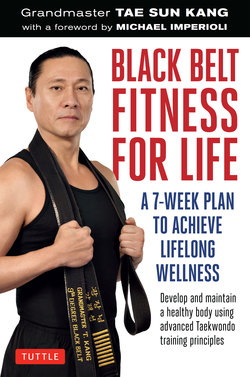Читать книгу Black Belt Fitness for Life - Grandmaster Tae Sun Kang - Страница 7
ОглавлениеForeword
by Michael Imperioli
My children started doing Taekwondo with Grandmaster Tae Sun Kang about six months before I started in 2003. I had been on the road, working on a couple of movies—two shootings back to back from the end of the summer until November. I returned to New York and was really out of shape. I was smoking cigarettes a lot, drinking too much, and not eating correctly. I hadn’t been exercising for a long time—in fact, many years—and I was really scared. I actually started with a couple of private lessons with Grandmaster because the idea of jumping right into the class with other students was a little bit frightening to me.
I had tried joining gyms, and I joined an aerobics-type class once, but I never stuck to anything as far as fitness programs went. I was afraid that I would eventually give up on this too, to be honest. I was afraid that I couldn’t hack it. I felt too old, too out of shape.
What got me through were a couple of things. The first thing was Grandmaster Kang—his integrity, and his genuine interest in the well-being of his students. He instilled in me the basics of Taekwondo, teaching me the basic kicks and some of the simpler stretches. He really instilled in me the idea that if I just stuck with it, then I would make some progress. Nothing’s going to happen if I didn’t come regularly. Because I was still smoking and I really wasn’t healthy, it was hard getting through these early workouts. But I remember saying to myself, “just get to the end, don’t quit.” I never had to stop a workout because of low endurance. I’ve gotten injured a little here and there and I had to stop taking classes for that, but other than those times, I’ve always made it through a class. I never said, “that’s it, I give up!”
There’s something to martial arts, and especially the way Grandmaster Kang teaches it, that addresses not just the body and fitness, but also the mind and your approach to life. The tenets that he promotes—courtesy, integrity, self-control, perseverance, indomitable spirit—these things are very present in his teaching, and they’re very important elements.
I was taken aback by the formality of bowing and calling everyone “sir” because I had never been in an atmosphere where you did that. I mean, I’m polite, as polite as anyone else, I would say. But it was a little off-putting at first and I was a little reluctant; I thought it was kind of strange, but now I really appreciate it. I feel it creates a very level playing field among students—we’re all equals. Whatever belt level we have, we still bow to each other. I bow to white belts because I have respect for their choice to come here.
To bow to your Grandmaster and to your instructors and to the flags, it gives a certain respect to these things and to the discipline. The respect you give it is that firstly, it may save your life one day, or the life of a loved one, or the life of a stranger on the street, because maybe you’ll have to defend them against someone who’s trying to do some serious harm. And it may save your life by the way that it’s going to keep you healthy, it’s going extend your life and keep your family healthy. It’s not just a trendy thing that’s going to get you six pack abs, although you can certainly achieve that if you try.
I think the respect shown at Grandmaster’s studio really separates this place from the outside world, and it’s not just another workout. It’s something that’s beneficial to mind, body, and spirit. I find myself calling people “sir” in life, too. And I think that’s all right. People appreciate that. I call people “sir” and “ma’am” all the time. We’re all human beings—if you show me respect and I show you respect, things will go a lot smoother in the world.
